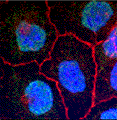Biochemistry, Department of
Document Type
Article
Date of this Version
10-1-2006
Abstract
Molecular mechanisms of prostate cancer progression are frequently studied in mice by orthotopic injection of aggressive cell lines, which yield primary tumors that spontaneously metastasize to lymph nodes. In this report, we characterized the human prostate carcinoma cell line 22Rv1 in an orthotopic system and evaluated the functional relevance of the hyaluronidase Hyal1, a correlate of invasive human prostate cancer, to progression in this model. To provide real-time insights into these processes, we first validated use of an epidermal growth factorconjugated fluorophore to illuminate orthotopic prostate tumors and their metastases in whole animal imaging. Animals receiving intraprostatic injections were tracked throughout a 6-week period. Tumor sizes were correlated 92% with total fluorescence intensities of 22 prostate tumors. In contrast to the highly tumorigenic and metastatic PC3M-LN4 cells, the 22Rv1 line was orthotopically tumorigenic but not metastatic, despite larger tumor sizes. Lymph node metastasis was successfully imaged in animals with PC3M-LN4 tumors on endpoint dissection. Stable transfection of 22Rv1 cells with Hyal1 did not alter growth kinetics of primary orthotopic tumors, but all animals implanted with Hyal1 transfectants exhibited tumor-positive para-aortic lymph nodes. Hyal1 is implicated as an inducer of prostate cancer metastatic progression.



Comments
Published in American Journal of Pathology 2006 October. Copyright © American Society for Investigative Pathology.